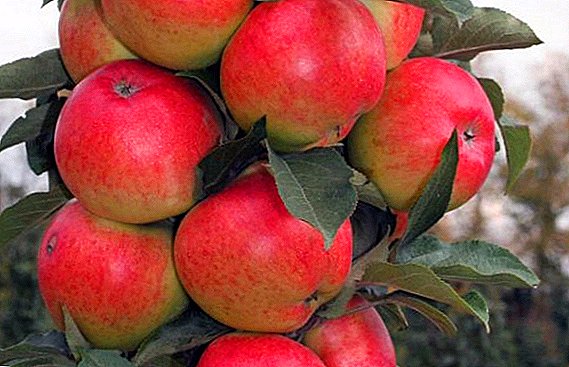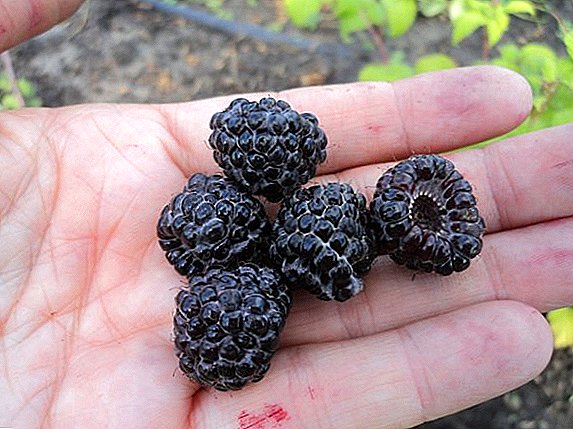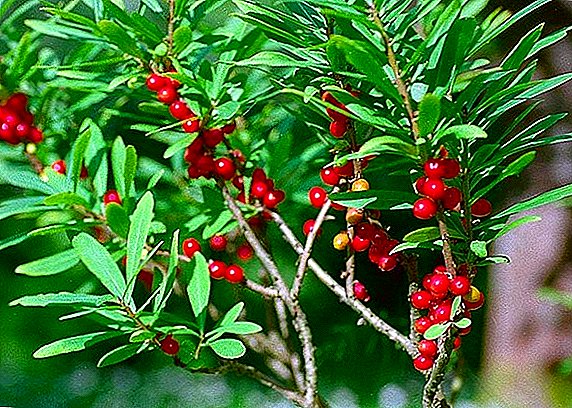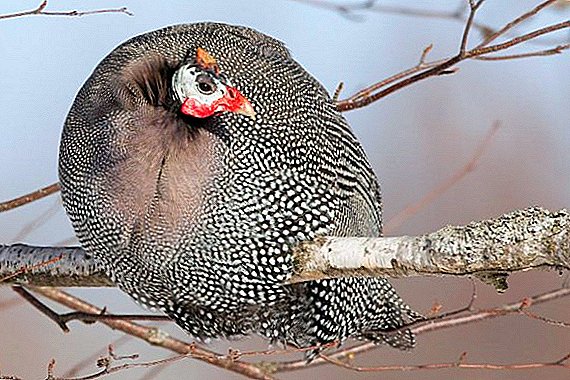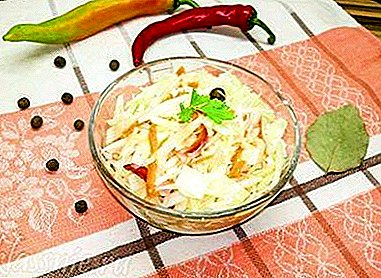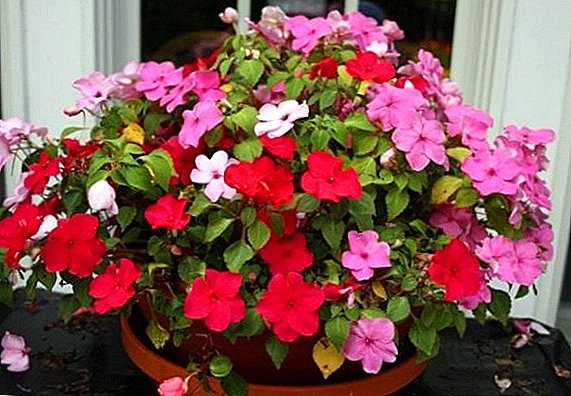 One of the most popular indoor plants, which has long been established on the windowsills of our apartments and houses, is a balsam (in this case, a room variant). Caring for this flower is not difficult, but you still need to know how to replant, propagate, water and fertilize room balsam at home.
One of the most popular indoor plants, which has long been established on the windowsills of our apartments and houses, is a balsam (in this case, a room variant). Caring for this flower is not difficult, but you still need to know how to replant, propagate, water and fertilize room balsam at home.
Common types of room balms
In our time, there are more than 400 species of this plant, which in some countries has been called "light" (the merit of very bright flowers). Balsam can be as an annual plant, and perennial, but Waller’s or Waller’s balsam (best known), ambal balsams, and New Guinean balsams, known as hybrids of the New Guinea group, are most common in our homes.
With good care, they can bloom all year round, delighting you with bright pink or red flowers. Nevertheless, there are varieties with flowers of yellow, orange, white and lilac flowers, but two-colored plants with a contrasting center (“eye”) are most original. Balsam leaves also have a wide variety of shades, ranging from standard green to red or brown.
 In any case, whichever option you choose, growing balsam from seeds at home will be a very interesting and exciting process for you.
In any case, whichever option you choose, growing balsam from seeds at home will be a very interesting and exciting process for you.
Did you know?The people balsam called "touchy." The fact is that after pollination of flowers, boxes with seeds are formed, which, at the slightest touch, burst immediately. The second, no less common version of his "name" is "Roly Wet."
The main rules of landing balsam
If you decide to acquire balsam at home, but do not know how to properly plant this plant, then the first thing to do is to buy quality seeds. When choosing them, it is important to pay attention to the shelf life, variety, type (annual or perennial) and reliability of the manufacturer. If you are willing to take a chance and experiment, you can prepare seeds yourself (for this, you will have to collect them manually from plants already existing in the farm).
 Before direct sowing of seeds in pots, place them in a weak solution of potassium permanganate for 10 minutes and then soak for another day in warm water.
Before direct sowing of seeds in pots, place them in a weak solution of potassium permanganate for 10 minutes and then soak for another day in warm water.
The next stage is proper soil preparation. Given that the seedlings of the plant are very sensitive to its type and composition, the soil for the room balsam should be light and loose. It is best to use a mixture of peat and leaf earth, vermiculite and river coarse sand (in equal proportions). But if you do not want to spend time, then you can buy ready-made land for seedlings, adding to it one-fifth of vermiculite or sand, which will make the soil loose and breathable.
Important! Many growers believe that the best for balsam is a weakly acid soil, consisting of equal shares of sod, perlite, humus and compost.The height of the capacity for seedlings should be 7 cm (or slightly more). For these purposes, you can use a plastic container, a pot or a wide bowl. In the bottom of the selected container, you should make several holes and apply a layer of expanded clay with a thickness of 2 cm. This will not allow water to linger in the soil and prevent the roots from rotting.
 Just before sowing seeds, it is necessary to fill the pot with earth and spill the solution of Fitosporin into it, which will help improve the soil microflora and protect it from many pests.
Just before sowing seeds, it is necessary to fill the pot with earth and spill the solution of Fitosporin into it, which will help improve the soil microflora and protect it from many pests.
The ideal time for sowing seeds is mid-March. In this case it will be possible to admire the first blossoming flowers of the young balsam in June.
An important point when sowing - a spacious placement of seeds in a pot, at an equal distance from each other. They need to be sown superficially, gently pressing a wet toothpick to the soil, but without immersion in it.
Important! The optimum temperature for germination of balsam seeds is + 22-25 ° C.After all the requirements have been met, and the seeds will take their place in the pot, all that remains is to spray the crops with water and place the container in a plastic bag, after filling it with air.
Recommendations for the care of indoor balm
Now let's figure out how to properly care for balsamic. Only a few requirements should be taken into account: compliance with the temperature regime, maintenance of the required level of humidity, knowledge of the characteristics of watering, feeding plants, as well as their pinching and pruning.
Selection and lighting
 The balsam loves bright light, but contact with the plant in direct sunlight can have an extremely negative effect on the flower. Therefore, growing the plant at home, it is necessary to shade the window.
The balsam loves bright light, but contact with the plant in direct sunlight can have an extremely negative effect on the flower. Therefore, growing the plant at home, it is necessary to shade the window.
At the same time, in the winter season, the room balsam will need a sufficient amount of light, which also contributes to its flowering all year round (in winter time the sun is not so bright).
In order for the crown of the bush to be evenly beautiful and even, the pot with the plant must be rotated periodically, alternately substituting each side of the sun. The lack of light often leads to the fact that the plant stops producing buds and loses its attractiveness.
Did you know? Room balsam is most suitable for people who were born under the sign of Leo.
Temperature and humidity
 Compliance with the ideal temperature and suitable humidity in the room is another important task that confronts the florist when growing balsam. In spring and summer, the flower perfectly tolerates a temperature of + 25 ° C and higher, but only with good access to fresh air and moisture of the substrate. In winter, temperatures should not fall below + 10-15 ° C.
Compliance with the ideal temperature and suitable humidity in the room is another important task that confronts the florist when growing balsam. In spring and summer, the flower perfectly tolerates a temperature of + 25 ° C and higher, but only with good access to fresh air and moisture of the substrate. In winter, temperatures should not fall below + 10-15 ° C.
Potted specimens of balsam are also demanding on air humidity. True, although they do not like overheating, but additional moisture is not always necessary.
For example, if the air temperature in the room does not exceed the value of 20-22 ° C, it will be enough just to ensure that the soil in the pots does not dry out.
Increasing the temperature above this value will lead to rapid evaporation of moisture and wilting of the plant. If you see that the thermometer has crossed the mark of + 25 ° C, then it’s time to take up a spray gun, which can be used to spray the leaves several times a day.
Important! At significant temperatures, there is a possibility of falling leaves due to the appearance of the "greenhouse effect" (high temperature and humidity). Therefore, it is best to find a cooler for the bush, but a fairly bright room.
Watering and feeding plants
 Balsam loves water, and watering is one of the most important agrotechnical requirements for caring for it. In the summer months, when the topsoil often dries out, the plant requires abundant watering. However, when introducing water into the soil, it is necessary to ensure that the liquid does not fall on the root neck of the plant. To do this, watering is performed on the edge of the pot, and after the procedure is completed, excess water is drained from the pan.
Balsam loves water, and watering is one of the most important agrotechnical requirements for caring for it. In the summer months, when the topsoil often dries out, the plant requires abundant watering. However, when introducing water into the soil, it is necessary to ensure that the liquid does not fall on the root neck of the plant. To do this, watering is performed on the edge of the pot, and after the procedure is completed, excess water is drained from the pan.
As a liquid for irrigation, it is better to prepare soft and separated water, otherwise you will soon find a white coating on the ground surface, which indicates its high alkalinity. In this case, experienced growers are advised to replace the top layer of soil.
In order to provide the roots with access to fresh air, the ground in the pot must be periodically loosened. Only you should not perform this procedure too deeply (no deeper than 1 cm), otherwise there is a possibility of damage to the root system of the plant.
For the full development of your balsam he also needs fertilizing. Usually it is introduced into the soil in the spring-summer period, when the plant begins to bloom.
Nowadays it is easy to find out how to feed balsam for flowering, because quite a lot of various fertilizers are represented on the modern market. However, in the midst of all this diversity, it is better to pay attention to complex fertilizers for ornamental flowering plants (in half-dosage once every two weeks), although each gardener decides how to feed "Vanka wet" based on the specific conditions of its maintenance.
Important! After balsam transplantation, fertilizers are applied not earlier than in three weeks.
Pinching and trimming
 In the process of balsam transplantation (usually in spring), the crown of the plant is “corrected”. So, if during the winter the bush has grown too much, then pruning a balsam (room) provides for shortening the stems by half. At the same time, when the shoots reach the desired length, their tops pinch, thus stimulating the emergence and growth of new lateral shoots and thick flowering.
In the process of balsam transplantation (usually in spring), the crown of the plant is “corrected”. So, if during the winter the bush has grown too much, then pruning a balsam (room) provides for shortening the stems by half. At the same time, when the shoots reach the desired length, their tops pinch, thus stimulating the emergence and growth of new lateral shoots and thick flowering.
Pinch is the mechanical removal of the top of the shoot, which is performed both with scissors or simply with your hands. Thanks to this action, dormant buds awaken, but if in a particular place they are undesirable, then after regrowth they are gently broken out.
Pruning helps rejuvenate the plant, and cut apical shoots are used for subsequent reproduction. In order to improve the decorative properties of the balsam, it is also necessary to remove old bare branches, as well as dying leaves and flowers.
How to transplant indoor balsam
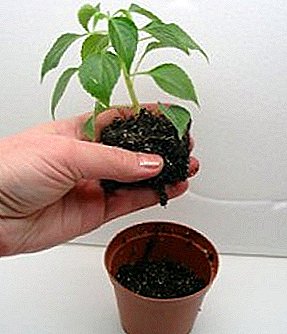 Among florists, one can often hear the following question: how to properly transplant the "wet Roly". First of all, you need to know that the room balsam is transplanted in the spring, and only in case of need they make a transplant in the summer. In addition, all young plants need an annual change in their habitat. An adult plant is either transplanted, or after 2-3 years it is simply renewed by rooting the top cuttings (this is a very important event, because with time the balsam grows and becomes less attractive).
Among florists, one can often hear the following question: how to properly transplant the "wet Roly". First of all, you need to know that the room balsam is transplanted in the spring, and only in case of need they make a transplant in the summer. In addition, all young plants need an annual change in their habitat. An adult plant is either transplanted, or after 2-3 years it is simply renewed by rooting the top cuttings (this is a very important event, because with time the balsam grows and becomes less attractive).
The most suitable time for home balsam transplantation is the end of February or the end of March, and the sequence of all actions is as follows:
- Take a pot of the right size (preferably bigger) and fill it with a quarter drain;
- Pour into the pot soil prepared according to the above recipe;
- Water the soil with warm, settled water;
- Before direct transplantation, moisten the soil in the pot, from which you are going to transplant the plant, so that the earth can be easily separated from the roots;
- Very carefully remove the plant from the old pot, after having dug it around on all sides (so it will be easy to take it out along with the earthy clod);
- Carefully inspect the roots and remove all injuries, cutting them to healthy tissue.
Did you know? In England, balsam is called "Diligent Lisa".
Propagation of room balsam
Propagation of room balsam can be done in two ways: cuttings and sowing seeds.
Cuttings
 Cutting is a more popular way to grow a plant. It is actively used in the spring or summer periods, cutting cuttings from balsam bushes. The length of the cut-off parts is from five to seven centimeters, and each of them must have at least two internodes. Leaves and buds located at the bottom must be removed.
Cutting is a more popular way to grow a plant. It is actively used in the spring or summer periods, cutting cuttings from balsam bushes. The length of the cut-off parts is from five to seven centimeters, and each of them must have at least two internodes. Leaves and buds located at the bottom must be removed.
How to properly cut balsam? In fact, this procedure is not as complicated as it may seem at first glance. Prepared stems can be put in a container with water before the formation of the roots, or immediately landed in the ground. As an ideal soil, it is better to use peat, vermiculite and perlite, mixing them in the same proportions. It is in this ground that the cuttings are placed, after which the soil is slightly compacted around them. Then the ground in the pot is moistened, and the container itself is placed in a plastic bag.
If the cuttings grow in a warm and bright room, they will root deeply within a fortnight, and after three months they will give you beautiful flowers.
Seeds
 To multiply balsam with seeds, you will need to prepare a ground mixture of perlite and peat (1: 2), and after planting the seeds, keep the temperature within + 20-25 ° C. You do not need to bury the seeds much in the ground; a depth of 0.7-1 cm will be sufficient. After sowing, the soil is sprinkled with water and placed under glass. Seeds should ascend in 8-10 days after planting (approximate terms).
To multiply balsam with seeds, you will need to prepare a ground mixture of perlite and peat (1: 2), and after planting the seeds, keep the temperature within + 20-25 ° C. You do not need to bury the seeds much in the ground; a depth of 0.7-1 cm will be sufficient. After sowing, the soil is sprinkled with water and placed under glass. Seeds should ascend in 8-10 days after planting (approximate terms).
In no case should not over-wetting the soil, as this may cause damage to seedlings "black leg". After the seedlings ascend, it will be possible to slowly accustom her to fresh air. When the seedlings reach 1.5-2 cm in height, they do a picking of the plants.
Important! The question of how to plant room balsam in separate pots should arise only when each seedling will have 1-2 true leaves.
Problems, diseases and pests of balsam, fight against them
Planting balsam in pots and creating the most favorable conditions for growth and development, one can never be sure that the plant is insured against all sorts of diseases and problems. For example, too high a temperature in a room with low air humidity does not in the best way affect the condition of the flower: the leaves wither, and the flowering slows down significantly. To return the plant to its former state, it is necessary to recreate the optimal conditions for its growth. However, we should not forget that the same abundant watering can harm the balsamine, because it contributes to the appearance of fungus and the development of mold.
 With the appearance of the first signs of a fungal disease, appropriate measures should be taken: the flower is immediately taken out of the pot and, carefully shaking off the roots of the accumulated soil, they are transplanted into a container with a new, more loose soil and a good drainage system.
With the appearance of the first signs of a fungal disease, appropriate measures should be taken: the flower is immediately taken out of the pot and, carefully shaking off the roots of the accumulated soil, they are transplanted into a container with a new, more loose soil and a good drainage system.
As soon as you find rot on the soil surface, replace the top layer with fresh earth. Running the disease, you will at times reduce the chances of a plant for salvation.
When the flowers fall, it is necessary to revise the conditions of balsam. In particular, the causes of "leaf fall" are often dry air, insufficient watering, reduced room temperature, poor lighting and over-feeding.
Poor lighting in the room and a lack of sunlight can also have a negative effect on the color of the leaves of variegated varieties, which, when there is a shortage of light, become pale and inexpressive. This factor is also the cause of too much stretching of the shoots, which adversely affects the decorative properties of the balsam.
 A weak flowering of the plant or its complete absence may be due to a shortage of nutrients or a bias towards nitrogen fertilizers that will stimulate the growth of foliage. Often, an unjustifiably large flower pot, supplemented by irregular watering, can often be the basis for such problems.
A weak flowering of the plant or its complete absence may be due to a shortage of nutrients or a bias towards nitrogen fertilizers that will stimulate the growth of foliage. Often, an unjustifiably large flower pot, supplemented by irregular watering, can often be the basis for such problems.
Among the rest of the balsam's illnesses, it is impossible not to isolate the defeat of the spider mite, which is facilitated by low humidity. You can get rid of the flower with the help of insecticidal solutions.
In addition, using special preparations, you can fight with aphids (or whitefly).


